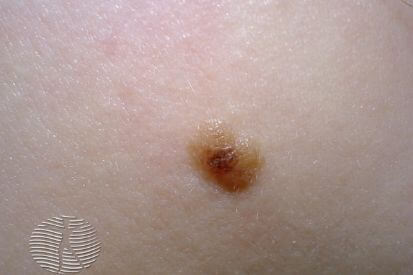Moles
Understanding Moles: Monitoring and Treatment
Moles are one of the most common skin growths and can appear anywhere on the body. It is important to keep an eye on any changes in an existing mole or the development of a new mole, and to bring them to the attention of one of our experienced dermatologists.
At Keystone Dermatology Partners, our dermatologists and skin experts carefully examine moles for any signs of irregularity or changes. During your skin check, they will provide personalized advice on sun protection to help prevent the formation of new moles and maintain skin health.
Learn more about moles and schedule your skin check with one of our trusted providers today to ensure your skin stays healthy and protected.
Examples of Moles




What are the Symptoms of Moles?
- Moles can be either raised or flat.
- The surface of the mole can be smooth or wrinkled and some may contain hair.
- Though generally brown or flesh-colored, moles may also appear tan, black, red or blue.
- As the body ages, moles may lighten in color, flat moles may become raised, and some moles may disappear.
Causes of Moles
- Genetics (Family History): Our genetic code significantly influences mole development.
- Sun Exposure: Spending time under the sun contributes to the appearance of moles.
- Hormonal Changes: Life events like pregnancy, marked by hormonal fluctuations, can influence the number of moles.
- Age: As we age, our skin accumulates more moles.
How to Prevent Moles
- Sun Protection: Shielding your skin from excessive sun exposure is crucial. Make sunscreen with at least SPF 30 a daily habit, even on cloudy days. Wear protective clothing, like hats and long sleeves, and seek shade during peak sunlight hours.
- Avoid Tanning Beds: Artificial tanning methods, such as tanning beds, can contribute to the development of moles. Opt for sunless tanning lotions or sprays as a safer alternative if you desire a sun-kissed glow.
- Regular Skin Checks: Keep an eye on your skin and monitor any changes in moles. If you notice alterations in size, shape, or color, or if new moles appear, consult one of our trusted skincare specialists promptly. Early detection can be crucial in preventing potential issues.
- Avoid Hormonal Fluctuations: While some hormonal changes are natural and inevitable, minimizing exposure to unnecessary hormonal fluctuations, such as those caused by certain medications, can be beneficial.
Frequently Asked Questions: Moles
Monitor your moles for any changes in size, shape, or color, as well as any signs of itching or bleeding. If you observe any alterations, it's important to consult a dermatologist. Regular self-examinations are key for early detection and effective management.
Although most moles are benign, any changes in their appearance may indicate skin cancer, such as melanoma. Regular total body skin exams performed by a dermatology professional are important for detecting these changes.
Protecting your moles from the sun is essential. Apply sunscreen regularly, wear protective clothing, and stay in the shade to avoid sun damage. Since moles are particularly sensitive to UV rays, these sun safety measures are vital.
Developing new moles, particularly during childhood and adolescence, is quite common. However, if you observe any quick changes or have concerns, schedule an appointment with your a dermatologist.
From our QualDerm Family of Brands: Total Body Skin Exams Explained By Audrey Moxie, PA-C
How to Treat Moles
Our team of dermatology providers can assess the mole's characteristics, considering factors such as size, shape, and color, to determine the most suitable course of action. Professional evaluation is especially vital when dealing with moles that exhibit irregularities or changes over time. Therefore, if you notice any changes in your moles or have specific cosmetic or discomfort-related concerns, consulting your dermatologist is a proactive step toward gaining healthy skin.
Featured Blogs

- Skin Cancer
- Sun Safety
When it comes to sunscreen, does a bigger (higher) SPF number mean its better than one with a smaller one? Discover the effectiveness of your sunscreen and what SPF you should be applying.
Read More
- General Dermatology
- Skin Care
Read this blog to explore the connection between chocolate consumption and acne.
Read More
- Skin Cancer
- General Dermatology
- Sun Safety
Use this blog as a guide to help you choose the most effective sunscreen to protect your skin.
Read More

